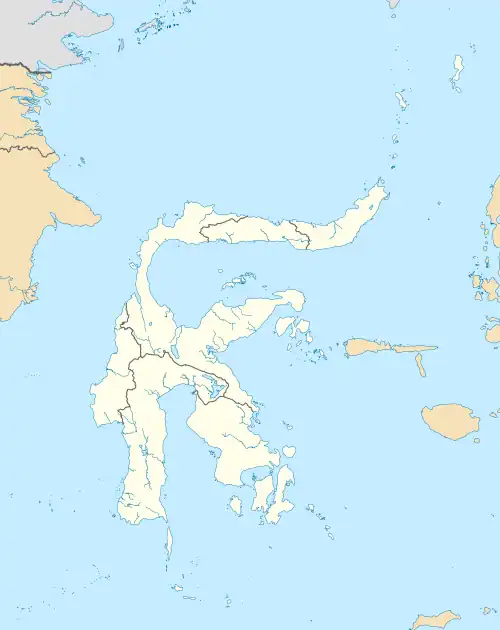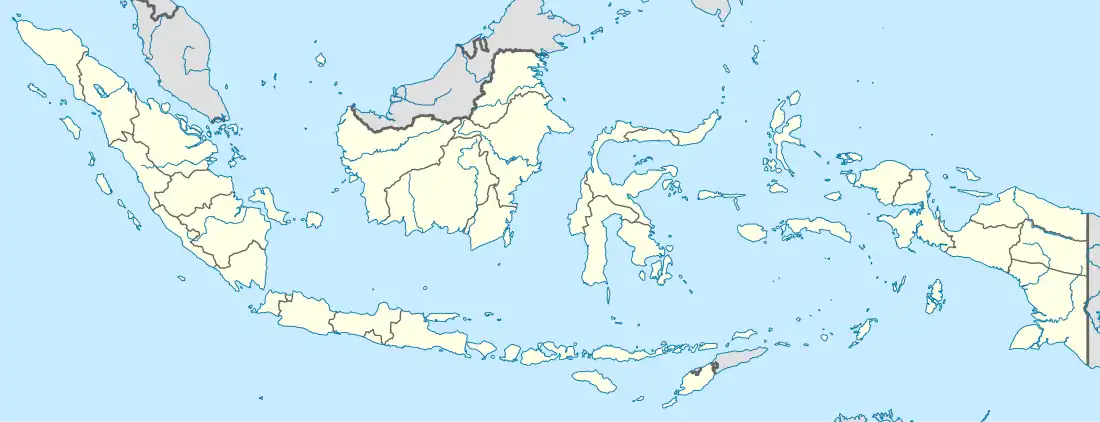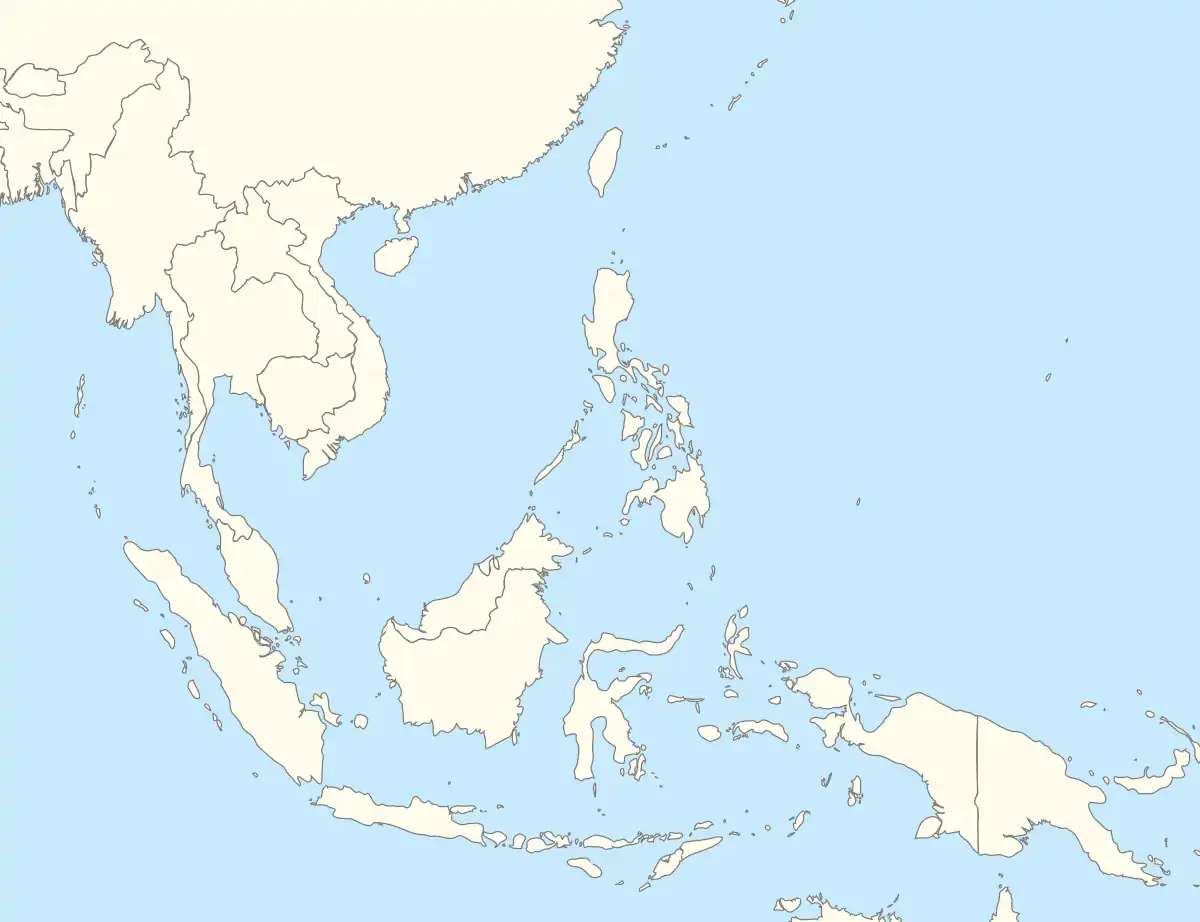Ponosakan language
Ponosakan is an Austronesian language spoken in the vicinity of the town of Belang, North Sulawesi, Indonesia. This language is almost extinct, with only four fluent speakers left as of November 2014.[1]
| Ponosakan | |
|---|---|
| Native to | Indonesia |
| Region | North Sulawesi |
| Ethnicity | Ponosakan people |
Native speakers | 4 (2014)[1] |
| Language codes | |
| ISO 639-3 | pns |
| Glottolog | pono1240 |
 Ponosakan  Ponosakan  Ponosakan | |
| Coordinates: 0°55′N 124°43′E | |
Classification
The locals in North Sulawesi often falsely identify Ponosakan as a Minahasan language.[2] However, there is no doubt among scholars that this language actually belongs to the Gorontalo–Mongondow subgroup.[3][4][5] The Gorontalo–Mongondow languages are commonly classified as a part of the Philippine subfamily; Robert Blust specifically includes it in the Greater Central Philippine languages, alongside—among others—Tagalog and Visayan languages.[6]
In comparison to other Gorontalo–Mongondow languages, Ponosakan is relatively conservative in terms of phonology and structure.[7]
Demography and distribution
Ponosakan is spoken at the eastern end of Gorontalo–Mongondow languages' distribution. This language has been spoken by the Ponosakan people in and around Belang from at least the 17th century.[7][8] Before World War II, Ponosakan was the most spoken language not only in Belang, but also in several other settlements around it.[8] But even in the 1920s, its number of speakers was already in decline.[9][11] Influx of migrants from other areas also altered the region's demography; when World War II started, already half of Belang residents were newcomers who did not speak Ponosakan. By the second half of the 20th century, "virtually no ethnic Ponosakans were learning the language anymore".[12]
In November 2014, there were reportedly only four elderly people who could still speak Ponosakan fluently.[1] Ponosakan has the fewest speakers among the Gorontalo–Mongondow languages.[7]
Phonology
There are 16 consonants and 5 vowels in Ponosakan.[2] In addition, the phoneme /ʤ/ only occurs in loanwords.[13]
| Labial | Alveolar/ Palatal |
Velar | Glottal | ||
|---|---|---|---|---|---|
| Nasal | m | n | ŋ | ||
| Stop | voiceless | p | t | k | ʔ |
| voiced | b | d | ɡ | ||
| Fricative | s | h | |||
| Lateral | l | ||||
| Trill | r | ||||
| Semivowel | w | j | |||
| Front | Central | Back | |
|---|---|---|---|
| Closed | i | u | |
| Mid | e | o | |
| Open | a |
Grammar
Pronouns
As with other Philippine languages, pronouns in Ponosakan are distinguished by case (nominative, genitive, and oblique);[14] number (singular and plural); and, for the first person plural pronouns, clusivity (inclusive and exclusive).[15] Other than the contrast between the singular and plural forms, Ponosakan also exhibits "count forms" for second and third person pronouns.[16] These forms are always followed by a number, as in siyatolu 'the three of them' and siya'opat 'the four of them'.[16] In contrast, plural forms cannot be followed by a number. Both the count and plural forms can be used to represent any number of people, although there is a preference towards using the count forms for smaller numbers.[16]
Case markers
There are three cases in Ponosakan: nominative, genitive, and oblique. Each case has its own marker, although the same marker is used for both nominative and genitive cases in common nouns.[16][17]
| Nominative | Genitive | Oblique | |
|---|---|---|---|
| Common | in | in | kon |
| Personal, SG | si | i | ki/kongki |
| Personal, PL | say | nay | konay |
Demonstratives
There are three root words for demonstratives in Ponosakan: (1) na’a 'near speaker (whether or not also near addressee)', (2) niyon 'near addressee (but not speaker)', and (3) tain or makota/takota 'far from both speaker and addressee'.[18] Examples of usage:[19]
Onu na'a? 'What's this? (near speaker, or near both speaker and addressee)' Onu niyon? 'What's that? (near addressee but not speaker)' Onu in tain? 'What's that? (far from both)'
Interrogatives
There are at least 16 interrogative words in Ponosakan. Most of them contain one of the following three roots: -onu, -onda, and -ʔene.[19][20] The form -onu by itself means 'what', but this root form can also be found in mo’onu 'when', mongonu 'why', songonu 'how much', and kosongonu 'how many times'. The form -onda when used in isolation means 'where' (used after verbs only), but this base can also be found in ko’onda 'where', na’onda 'how (manner)', and ta’onda 'which'. The base -ʔene is prefixed with case markers for personal names to form personal interrogatives (see table 3): si’ene 'who (nominative)', i’ene 'who (genitive)', and ki’ene 'to whom (oblique)'; or, for the plural forms, say’ene, nay’ene, and konay’ene. The only interrogative word which doesn't show any of the above base forms is oyo 'why'.[19]
Negators
Negation in Ponosakan is found in several forms. The word deya' 'no' negates verbs, adjectives, existence or location. The word dika 'don't!' is used to negate commands. The word di’iman 'not' negates nouns and equational sentences. There are also doi’ which means 'don't like, doesn't like' and ta’awe which means 'I don't know'.[21]
References
Footnotes
- Lobel 2015, p. 396.
- Lobel 2015, p. 399.
- Sneddon 1970, p. 13.
- Usup 1986, p. 35.
- Sneddon & Usup 1986, p. 410.
- Blust 1991, p. 73, 85.
- Lobel 2015, p. 397.
- Lobel 2015, p. 429.
- Lobel 2015, p. 431.
- Adriani, N. (1925). "De Minahasische talen" [The Minahasan language]. Bijdragen tot de Taal-, Land- en Volkenkunde (in Dutch). 81 (1): 135. doi:10.1163/22134379-90001541.
- Het Ponosakansch, thans reeds aan 't verdwijnen... [Ponosakan, now already disappearing][10]
- Lobel 2015, p. 430.
- Lobel 2016, p. 397.
- Lobel 2016, p. 399.
- Lobel 2015, pp. 413.
- Lobel 2015, pp. 415–416.
- Lobel 2016, p. 401.
- Lobel 2015, pp. 417.
- Lobel 2015, pp. 418.
- Lobel 2016, p. 402.
- Lobel 2015, pp. 420.
Bibliography
- Blust, Robert (1991). "The Greater Central Philippines hypothesis". Oceanic Linguistics. 30 (2): 73–129. doi:10.2307/3623084. JSTOR 3623084.
- Lobel, Jason William (2015). "Ponosakan: A Dying Language of Northeastern Sulawesi". Oceanic Linguistics. 54 (2): 396–435. doi:10.1353/ol.2015.0022. JSTOR 43897709. S2CID 146182992.
- Lobel, Jason William (2016). "Notes from the Field: Ponosakan: The Sounds of a Silently Dying Language of Indonesia, with Supporting Audio". Language Documentation & Conservation. 10: 394–423.
- Sneddon, James N. (1970). "The languages of Minahasa, North Celebes". Oceanic Linguistics. 9 (1): 11–36. doi:10.2307/3622930. JSTOR 3622930.
- Sneddon, James N.; Usup, Hunggu Tadjuddin (1986). "Shared sound changes in the Gorontalic language group: Implications for subgrouping". Bijdragen tot de Taal-, Land- en Volkenkunde. 142 (4): 407–26. doi:10.1163/22134379-90003347. JSTOR 27863783.
- Usup, Hunggu Tadjuddin (1986). Rekonstruksi protobahasa Gorontalo–Mongondow [The reconstruction of the protolanguage of Gorontalo–Mongondow] (PhD Dissertation) (in Indonesian). Universitas Indonesia.
External links
- Ponosakan word list from the Austronesian Basic Vocabulary Database
- Ponosakan Talking Dictionary from the Living Tongues Institute for Endangered Languages—contains 382 separate entries with an audio recording for each of them.